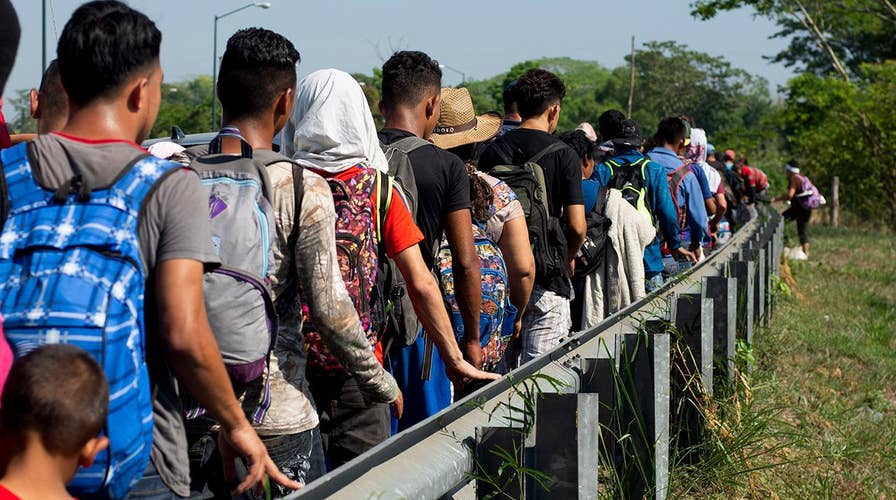Majority of illegal immigrants in US receiving taxpayer-funded government benefits
Central American migrants are arriving by the thousands without a penny to their name. How do they get by? William La Jeunesse breaks down the cost.
This week, the U.S. Supreme Court considers whether to count self-identified illegal immigrants in the 2020 census. Cities worry adding the citizenship question could undercount 6.5 million people. Their argument, however, isn't just about political power but billions of dollars in federal funds states expect.
The case underscores what experts say is a growing cost to taxpayers from the surge of Central American families and unaccompanied minors.
"We're talking about billions of dollars in taxpayer benefits over the next few years," said Dan Stein, director of the right-leaning think tank, Federation for American Immigration Reform. "The payout for the taxpayer is enormous and income to the Treasury is miniscule."
A FAIR study in 2017 found illegal immigrants are a net consumer of taxpayer benefits worth more than $100 billion a year, not including the cost of enforcing the border.
While federal benefits are supposed to be off limits, in practice many are not. More than 25,000 undocumented workers receive subsidized housing, according to the U.S. Department of Housing and Urban Development. Children receive free education and most qualify for English lessons and free school breakfast and lunch.
NEW MEXICO COUNTY DECLARES STATE OF EMERGENCY OVER SURGE OF ILLEGAL IMMIGRANTS CROSSING THE BORDER
Illegal immigrants do not qualify for Obamacare but under federal law, hospitals and clinics are required to provide urgent medical care without regard to legal status. Pregnant women are entitled to prenatal and postpartum care under the Women, Infants and Children program. Infant delivery costs are paid for by Medicaid. A study in the Journal of the American Medical Association found a federal-state immigrant insurance program cost $2 billion a year in emergency treatment, not including the $1.24 billion in infant delivery expenses.
Illegal immigrants are not entitled to food stamps, but families with U.S.-born children are. According to the Center for Immigration Studies, 31% of such families use the SNAP program and more than 50% of Central American families in the U.S. use at least one welfare program.
This is especially true of asylum seekers said Art Arthur, a former immigration judge now with the Center for Immigration Studies, an immigration think tank. Arthur said because there is a three to five year lag time between apprehension and court appearance, young asylum seekers put down roots, allowing many to access programs they are initially unaware or afraid to use.
"You're going to buy a house, get a job, have kids," he said. "So their entire life changes, and that means their claim changes. Because of a lack of a bright line for immigration judges, appeals are endless and people don't leave."
Recognizing that many illegal workers fill jobs communities need, 26 states offer them *state-funded* benefits. New York state offers up to $300 a month in cash assistance. Eleven states offer free or subsidized medical and hospital care. California offers food stamps, legal services and benefits for those over 65 or disabled. Gov. Gavin Newsom recently asked for an extra $50 million from lawmakers to serve the state's illegal immigrant population.
VICE PRESIDENT MIKE PENCE: CONGRESS MUST ACT TO END THE CRISIS ON OUR BORDER
Such sanctuary states and immigrant-friendly cities are an obvious draw, but others say it is all about finding work not using benefits.
The Current Population Survey conducted by the U.S. Census Bureau in 2018 found Central American families may struggle financially in the U.S. but they work (76%) at high rates than native-born Americans (73%).
"At the end of the day people are going to go where their jobs are, not necessarily where the services are," said Ali Noorani, director of the National Immigration Forum. "So yes, 26 states may provide state-funded access to public benefits. But if those states don't have a growing economy and don't have jobs that are open immigrants, much as anybody else, they're not going to see them."
Up to 70% of immigrants apprehended at the border this fiscal year are families or unaccompanied minors claiming asylum. Unlike other border crossers, after six months asylum seekers qualify for work permits and most taxpayer subsidies. But because most are unskilled and uneducated, they earn minimum wage or less.
Almost half, according to the census survey, never finished high school. They earn 40% less than U.S.-born workers and about 50% of families live in poverty, requiring community support for food and cash for necessities. Some have sponsors, but most are usually immediate families that are not much better off.
"There is a cost for communities for sure," Sen. Martha McSally, R-Ariz., said last week outside a Salvation Army shelter in Yuma. "Whether it is in uncompensated care in hospitals or the education system in different ways. It has never really been measured, but it is very real."
CLICK HERE TO GET THE FOX NEWS APP
Advocates for illegal immigrants argue most studies are flawed because they do not account for their economic contribution to the economy as a whole. Not just because they perform jobs Americans won't, but studies don't account for their lower wage differential that produces cost savings to U.S. consumers.
"We need an immigration system that treats the American taxpayer fairly," Noorani said. "Right now, our immigration system doesn't treat the American taxpayer fairly and I would argue it really treats nobody fairly. At the federal level, what the Congress and the president need to do is work together to create an immigration system that is fair to the taxpayer and 10 or 11 million people who are undocumented."
U.S. officials expect a million additional illegal immigrants this fiscal year, as the Border Patrol is currently apprehending up to 4,000 a day. Most will claim asylum, entitling them to government benefits.






















